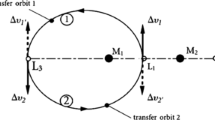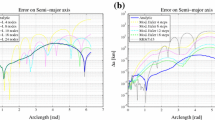Abstract
In order to solve the problem of deflecting a dangerous asteroid from a collision orbit with the Earth, using a low-thrust engine directed tangentially to the trajectory is considered. The engine can be mounted on the asteroid or on a “gravity tractor.” The purpose of this study is to establish the fundamental possibility of steering away an asteroid to a safe distance over times of approximately a month and a year. This is acceptable since an asteroid with about a 100-m diameter is unlikely to strike immediately after its discovery. We limited ourselves to a model statement of the problem: the engine provides constant tangential acceleration. Previously, we transformed the respective Euler equations using the averaging method. Here, we solve them by the method of series in powers of “slow time” and demonstrate the adequacy of the solution on the time intervals of decades. It turns out that asteroids up to 55 m in diameter can be deflected in a year with an engine thrust of 1 N. With a thrust of 20 N, asteroids up to 50 m in diameter can be deflected in a month, and asteroids with a diameter of up to 150 m, in a year. Diverting larger asteroids requires more time or more powerful engines. The results are compared with the previously obtained similar data for the case of the transversal perturbing acceleration. The tangential traction leads to better results in all cases; however, both variants nearly coincide for orbits with eccentricities up to 0.4. The difference becomes significant at \(e > 0.5\).

Similar content being viewed by others
Notes
This is not the case for meter- and decameter-sized bodies that are discovered just in the immediate vicinity of the Earth. However, there is no need to deflect such small bodies; giving a public warning is sufficient.
All the values are given in the SI system, unless otherwise indicated.
REFERENCES
T. N. Sannikova and K. V. Kholshevnikov, Vestn. SPbGU, Ser. 1: Mat. Mekh. Astron., No. 4, 134 (2013).
T. N. Sannikova and K. V. Kholshevnikov, Astron. Rep. 58, 945 (2014).
N. Batmunkh, T. N. Sannikova, and K. V. Kholshevnikov, Astron. Rep. 62, 288 (2018).
E. T. Lu and S. G. Love, Nature (London, U.K.) 438 (11), 177 (2005).
Yu. D. Medvedev, M. L. Sveshnikov, A. G. Sokol’skii, E. I. Timoshkova, Yu. A. Chernetenko, N. S. Chernykh, and V. A. Shor, Asteroid-Comet Hazard, Ed. by A. G. Sokol’skii (IPA RAN, St. Petersburg, 1996) [in Russian].
A. M. Mikisha and M. A. Smirnov, in Threat from the Sky: Rock or Chance?, Ed. by A. A. Boyarchuk (Kosmoinform, Moscow, 1999) [in Russian].
N. N. Gor’kavyi and A. E. Dudorov, Chelyabinsk Superbolid (Chelyab. Gos. Univ., Chelyabinsk, 2016) [in Russian].
A. V. El’kin and L. L. Sokolov, in Proceedings of the Conference on Asteroid Hazard-95, St. Petersburg, May 23–25,1995 (MIPAO and ITA RAN, St. Petersburg, 1995), Vol. 2, p. 41.
G. L. Grodzovskii, Yu. N. Ivanov, and V. V. Tokarev, Space Flight Mechanics (Optimization Problems) (Nauka, Moscow, 1975) [in Russian].
V. N. Lebedev, Calculation of the Motion of a Spacecraft with Low Thrust (Vychisl. Tsentr AN SSSR, Moscow, 1968) [in Russian].
N. Batmunkh, K. I. Os’kina, T. N. Sannikova, V. B. Titov, and K. V. Kholshevnikov, Astron. Rep. 63, 954 (2019).
N. N. Bogolyubov and Yu. A. Mitropol’skii, Asymptotic Methods in the Theory of Nonlinear Oscillations (Fizmatlit, Moscow, 1963; Gordon and Breach, 1961).
D. Brower and G. Clemence, Methods of Celestial Mechanics (Academic, New York, 1961).
H. Poincare, Lectures on Celestial Mechanics (Springer, Berlin, 1971).
M. F. Subbotin, Introduction to Theoretical Astronomy (Nauka, Moscow, 1968) [in Russian].
W. Gröbner, Die Lie-Reihen und ihre Anwendungen (VEB Deutscher Verlag der Wissenschaften, Berlin, 1967).
G. E. O. Giacaglia, Perturbation Methods in Non-Linear Systems (Springer, New York, 1972).
A. H. Nayfeh, Perturbation Methods (Wiley, New York, 1973).
K. V. Kholshevnikov, Asymptotic Methods of Celestial Mechanics (Leningr. Gos. Univ., Leningrad, 1985) [in Russian].
K. V. Kholshevnikov, N. Batmunkh, K. I. Os’kina, and V. B. Titov, Astron. Rep. 64, 369 (2020).
N. Batmunkh, T. N. Sannikova, K. V. Kholshevnikov, and V. Sh. Shaidulin, Astron. Rep. 60, 336 (2016).
Funding
The study was funded by the Russian Science Foundation (grant no. 18-12-00050).
Author information
Authors and Affiliations
Corresponding authors
Additional information
Translated by M. Chubarova
ESTIMATES OF SOME COMPLEX VARIABLE FUNCTIONS
ESTIMATES OF SOME COMPLEX VARIABLE FUNCTIONS
Let \(0 < {{e}_{0}} < 1\), \(0 \leqslant \alpha \leqslant 1\), \(0 \leqslant \psi < 2\pi \), \(z \in \mathbb{C}\), \({\text{|}}z{\text{|}} \leqslant 1\),
Let us estimate the absolute values of functions (37). Obviously, \({\text{|}}e(\psi ){\text{|}} \leqslant 1\),
The derivative
vanishes at
and when \({{e}_{0}} < 1{\text{/}}\sqrt 2 \) also at
From here, we easily derive
where
The triangle axiom for points \(1\), \(z\), \(\alpha z\) of the complex plane gives
Further,
Indeed, (40) follows from the obvious inequality
Relations (39) and (40) imply the inequality
Hence, we obtain the estimate of \({{g}_{2}}(e)\):
Rights and permissions
About this article
Cite this article
Kholshevnikov, K.V., Milanov, D.V., Os’kina, K.I. et al. Deflecting an Asteroid with a Low-Thrust Tangential Engine to the Orbit. Astron. Rep. 64, 785–794 (2020). https://doi.org/10.1134/S1063772920100029
Received:
Revised:
Accepted:
Published:
Issue Date:
DOI: https://doi.org/10.1134/S1063772920100029




